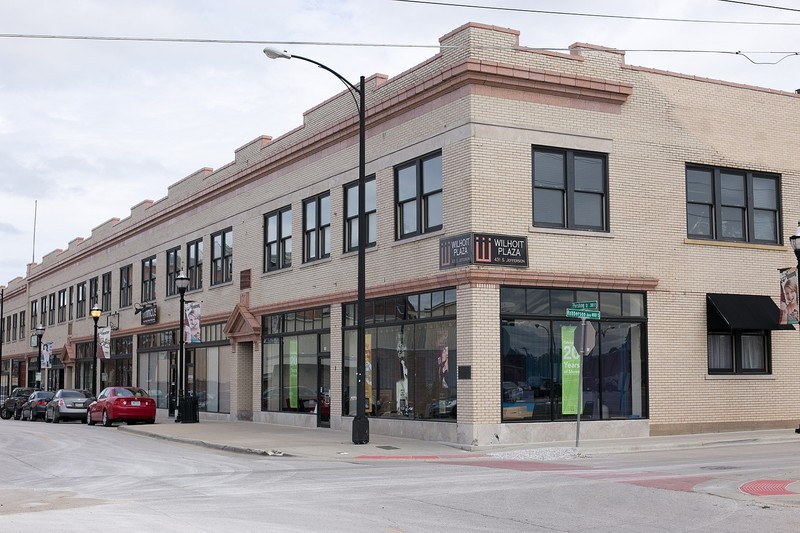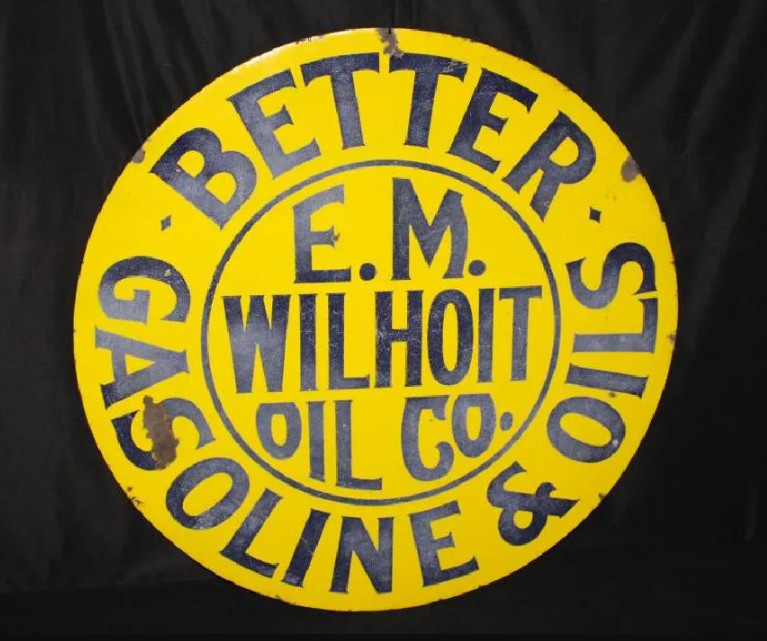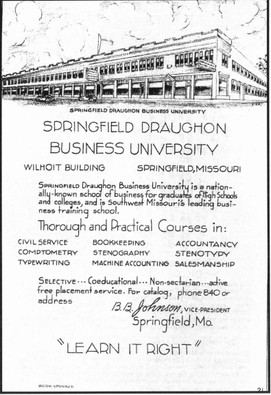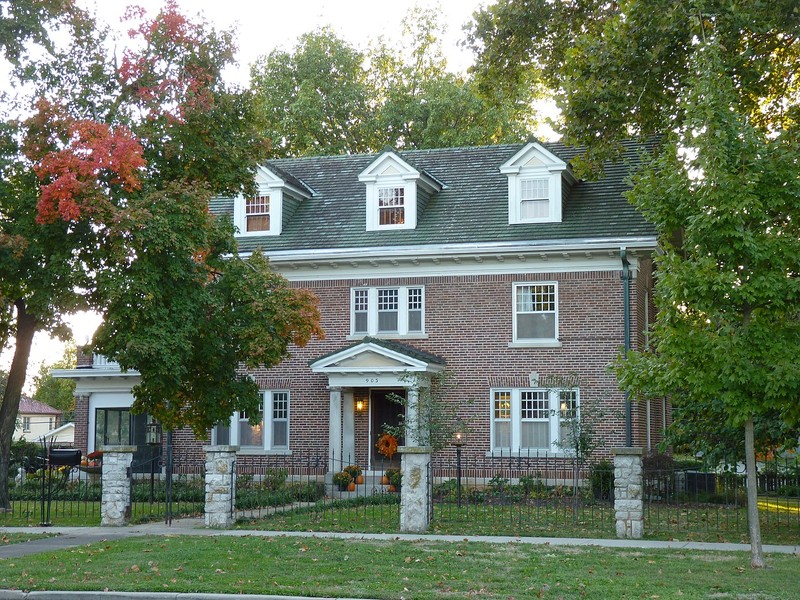E. M. Wilhoit Building; E.M. Oil Company
Introduction
Text-to-speech Audio
The E.M. Wilhoit Building (circa 1926) served as the headquarters of the E.M. Wilhoit Oil Company, the largest independent oil retailer in the Ozarks region during the twentieth century. Wilhoit worked for Standard Oil Company for nine years before deciding to create the E. M. Oil Company, which eventually operated nearly 100 fuel and distribution stations, as well as an oil refinery. Additionally, the Draughon Business College, Springfield's largest vocational business school (founded in 1907), occupied the second floor as an anchor tenant from 1926 - 1977. The building arose at a time when Springfield enjoyed a commercial building boom.
Images
E. M. Wilhoit Oil Company Building

Wilhoit Oil Company sign

Advertisement for the Draughon Business School, located in the Wilhoit Oil Company Building

Edward M. and Della C. Wilhoit House at 903 S. Weller Ave., Springfield, Missouri. The home is also listed on the NRHP.

Backstory and Context
Text-to-speech Audio
Edward M. Wilhoit built a successful, independent oil business that earned him the nickname "Oil King of the Ozarks." He took his first job in the oil industry in 1888 as a wagon driver for the Standard Oil Company. He stayed with the company for eight years, moving to Topeka, Kansas, during that time. In 1896, he left Standard Oil to form an independent oil agency in Joplin, Missouri; quite a bold move given the stronghold large oil companies had on the industry by the late nineteenth century. Wilhoit's first station in Joplin initially sold kerosene but soon offered gasoline as cooking fuel.
In 1902, the company expanded to Springfield, Missouri, and two years later, the Wilhoits also moved to Springfield. A demonstration of E. M.'s success, the couple purchased a home within Springfield's exclusive middle- and upper-class residential neighborhood. By 1910, a boom in population and residential construction created a considerable demand for lighting fuel. And, by the 1910s and more so by the 1920s, increased automobile ownership led to greater gasoline needs. As the demand for fuel grew, Wilhoit Oil Company expanded with new stations opening across all of Western Missouri and Eastern Kansas. The company also developed its own oil refinery in Joplin. By 1916, the E.M. Wilhoit Company became the largest independent oil distributor in the Ozarks region.
After a brief stint in Kansas City around 1915, the couple moved back to Springfield and built a Georgian Revival Style home (listed on the National Register of Historic Places). The family also purchased a rural farm, which served as a family retreat and spoke to the wealth they enjoyed. Thus despite the challenges, E. M. left Standard Oil and managed to build his own company into an empire consisting of seventy service stations and fifty bulk distribution stations across Missouri and Eastern Kansas by the mid-1920s.
By the mid-1920s, the Wilhoit Company made plans to build a new headquarters in downtown Springfield. Springfield, including its downtown and Public Square areas, enjoyed steady growth from the Civil War through the 1920s, transforming from a once sparsely-populated Ozark frontier town to the region's commercial hub. Although much of its development occurred in the decades prior to World War I, the expanding nationwide economy of the 1920s included a commercial construction boom around Springfield's Public Square; the Wilhoit Building arose during that period. When the historic building opened in 1926, the Wilhoit Company, with its new building possessing 140,000 square feet of commercial space, claimed to own the largest floor space of any structure in Springfield. However, other buildings, such as the Herr Department Store, complicate that argument. Nevertheless, the Wilhoit Building did cover an entire city block, thus having the largest footprint in the Public Square area.
In addition to the Wilhoit company, its early principal tenants included several auto-related businesses and, most significantly, Draughon Business College. The Business College served as an anchor tenant and representative of Springfield's commercial and overall job growth. Draughon College first opened in Springfield in 1907 with scanty enrollment, but by the 1920s, enrollment grew to 600 students. The growth coincided with the commercial expansion of Springfield; strong demand for vocational education emerged. To accommodate the school's increased enrollment, the college moved to the second floor of the Wilhoit Building. The new Wilhoit Building location provided ample classroom accommodations for an annual enrollment of 1,000 students, with a daily attendance of 300 to 400. Students attending Draughon learned shorthand, typewriting, bookkeeping, commercial law, business administration, and banking skills.
In 1928, only a mere two years after construction on the building finished, Wilhoit began divestiture of the oil "empire" he had built, selling the nearly 100 service and distribution stations across Missouri and Kansas (known as the Wilhoit Belt) to Phillips Petroleum Company. Wilhoit retained ownership of the E.M. Wilhoit Oil Company Refinery in Joplin and the historic E.M. Wilhoit Building in Springfield. Maintaining ownership of the building was a profitable decision given the success of the Draughon Business College as an anchor tenant. Although he had planned to enjoy his retirement by traveling the country, he died only a few months later in 1929.
The family maintained ownership of the building until 1940, and the Draughon Business College remained in the building until the 1970s. However, during the 1970s, the college's enrollment had decreased significantly, and unethical (and illegal) management practices ultimately led to its demise; the college officially closed in 1991.
Sources
Burton, Richard Lee. "Registration Form: E.M. Wilhoit Building." National Register of Historic Places. mostateparks.com. 2004. https://mostateparks.com/sites/mostateparks/files/Wilhoit%2C%20E.M.%2C%20Bldg.pdf
--- --- ---. "Registration Form: Wilhoit. Edward M. and Delia C.. House." National Register of Historic Places. mostateparks.com. 2004. https://mostateparks.com/sites/mostateparks/files/Wilhoit%2C%20Edward%20M.%20and%20Della%20C.%2C%20House.pdf.
Fairbanks, Jonathan and Clyde Edwin Tuck. Past and Present of Greene County, Missouri. Volume I. Indianapolis: A.W. Bowen & Company, 1915. https://thelibrary.org/lochist/history/paspres/index.html.
Thomason, Philip. "Registration Form: Springfield Warehouse and Industrial Historic District." National Register of Historic Places. mostateparks.com. 1999. https://mostateparks.com/sites/mostateparks/files/Springfield%20Warehouse%20and%20Industrial%20HD.pdf.
By Joseph Bulger - Own work, CC BY-SA 3.0, https://commons.wikimedia.org/w/index.php?curid=36681134
Live Auctioneers: https://www.liveauctioneers.com/item/68718463_42-porcelain-em-wilhoit-oil-co-gasoline-oils-sign
National Park Service, National Register of Historic Places. https://mostateparks.com/sites/mostateparks/files/Wilhoit%2C%20E.M.%2C%20Bldg.pdf
By AbeEzekowitz - Own work, CC BY-SA 3.0, https://commons.wikimedia.org/w/index.php?curid=11794564
